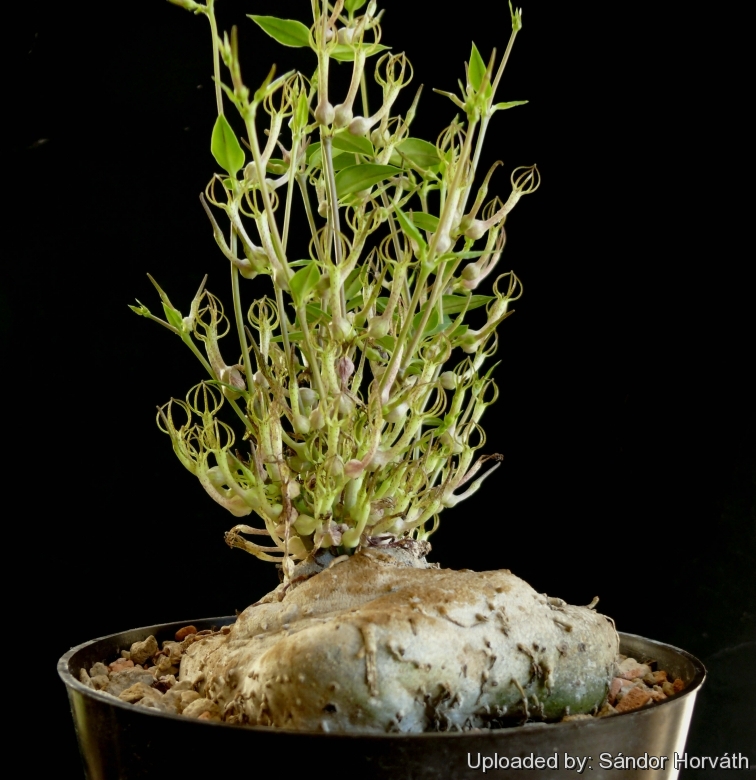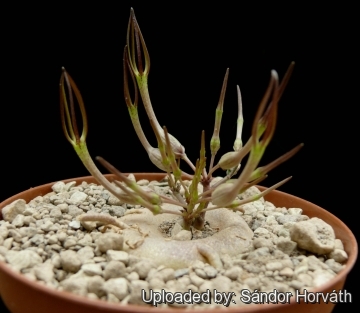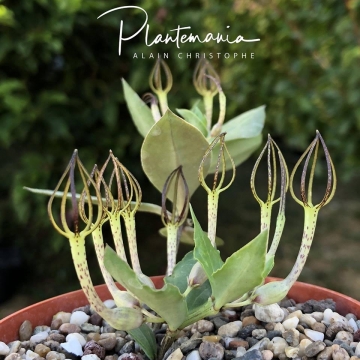




Your support is critical to our success.
- Encyclopedia of SUCCULENTS
- Encyclopedia Index
- Families
- Genera
- Species
- Asclepiadaceae
- Ceropegia
- Caudiciforms
Since 4 Aug 2013

Origin and Habitat: South Africa (KwaZulu-Natal, Gauteng, Northern Prov.). and extends as far north as Botswana and possibly Zimbabwe.
Type locality: Transvaal, Modderfontein.
Habitat and ecology: Ceropegia conrathii grows in isolated colonies in open grassveld. It also grows near the coast in Zululand, Natal, which indicates an affinity with a dwarf form of Ceropegia fortuita R. A. Dyer. The population trend is stable.
Synonyms:
- Ceropegia conrathii Schltr.
Description: Ceropegia conrathii is an herbaceous perennials with erect crowed stems, not twining, with a large root tuber (caudex). It is one of the shortest species in the genus, the whole plant including the tuber is only 8-12 cm high. From its concave apex annual inflorescences with very odd greenish yellow flower are produced synchronously in spring, the linear petals are united at the tips to form a bulbiform cage-like structure above the tube, but sometimes breaking free. The numerous greenish yellow flowers initially appear together with the annual leaves, but in mature plants the depressed centre of the caudex becomes crowded with buds. A musty smell from the flower attracts numerous small pollinating insects.
Derivation of specific name: This species was named after Paul Conrath, (1861–1931), Bohemian-Austrian naturalist and chemist and manager of a dynamite factory at Modderfontein, near Johannesburg, early in the twentieth century.
Tuber: Depressed-subglobose, 3-10 cm in diameter, 2 - 7 cm hight.
Stems: Several or perhaps numerous, arising annually or perennial, fleshy, clustered, erect, terete, simple or branched near the base, glabrous, 6 - 12 cm long, 1-2 mm in diameter, about half their length buried in the ground.
Leaves: Sessile or very shortly petiolate, suberect or ascending, at the time of flowering 12-30 mm long, 4-12 mm broad, probably afterwards enlarging, narrowly lanceolate to ovate, very acute, cuneately narrowed at the base, wavy and crisped at the margins, sparsely ciliolate, glabrous on both sides, apparently somewhat fleshy, sometimes developing only after the flowers.
Flowers: In sessile, extra-axillary, clusters of 1–6 at the nodes, all flowers opening simultaneously. Pedicels erect, 7-15 mm long, slender, glabrous. Sepals nearly 2 mm long, 1 mm broad, ovate-lanceolate, acuminate, glabrous. Corolla 3.5 cm long, very slightly curved, greenish yellow coloured. Tube cylindrical 12 mm long, ± 2.5 mm in diameter, inside with scattered hairs, 8-10 mm in diameter at the ellipsoid-inflated base, cylindric above and about 3-4 mm in diameter, not enlarged at the mouth, glabrous outside, very sparsely hairy at the middle part and having a few very short cylindric processes on the inflated part within, apparently whitish or yellowish, dotted with dark violet-purple on the upper part, the spots becoming more crowded below and perhaps confluent on the inflated part. Lobes about 7-8 mm long, linear, scarcely dilated at the base, erect, slightly curved, connate at the tips to form a bulbiform cage, but sometimes breaking free, glabrous, apparently purplish tinted. Corona white, shallowly campanulate, glabrous. Outer corona forming 5 small truncate pockets with U-shaped upper margins less than 0.5 mm deep alternating with the anthers, glabrous; inner corona-lobes 1-1.5 x 0.3 mm, linear-spathulate, obtuse, connivent-erect, dorsally adnate to the outer corona at the base, glabrous.
Fruits (follicles): Slender, terete,10 cm long, 4 mm wide. The two-horned follicles are typical for the genus as a whole.
Related species: Ceropegia conrathiiSN|32215]]SN|32215]] is closely related to the twining Ceropegia floribunda and sometime considered synonyms. Huber (1957).
Bibliography: Major references and further lectures
1) N. E. Brown “Flora Capensis”, Vol 4, 1909
2) J.P. Roux “Flora of South Africa”, 2003
3) Focke Albers, Ulrich Meve “Illustrated Handbook of Succulent Plants: Asclepiadaceae” Volume 4 Springer, 2002
4) Manyama, P.A. & Kamundi, D.A. 2006. Ceropegia conrathii Schltr. National Assessment: Red List of South African Plants version 2015.1. Accessed on 2016/01/05
5) James Cullen, Sabina G. Knees, H. Suzanne Cubey “The European Garden Flora Flowering Plants: A Manual for the Identification of Plants Cultivated in Europe, Both Out-of-Doors and Under Glass” Cambridge University Press, 11 August 2011
6) Urs Eggli, Leonard E. Newton “Etymological Dictionary of Succulent Plant Names” Springer Science & Business Media, 29 June 2013
7) Aloe 18: 30 1980
8) Flora of southern Africa 27(4): 68, 1980
9) Robert Allen Dyer “Ceropegia, Brachystelma and Riocreuxia in southern Africa”. VIII, 242 S., Rotterdam, Balkema, 1983
10) Rowley, “Caudicifonn & pachycaul succulents” 34, 77, 1987
11) Inez C. Verdoorn, L. E. W. Codd “Flowers of the Transvaal” Trustees, Wild Flowers of The Transvaal Book Fund, 1962
12) Keith Grantham, Paul Klaassen “The plantfinder's guide to cacti & other succulents” Timber Press, 18 May 1999
13) Huber, H. “Revison der gattung Ceropegia”. Mem. Soc. Brot. 12: 1–203. 1957

Ceropegia conrathii Photo by: Sándor Horváth

Ceropegia conrathii Photo by: © Plantemania

Ceropegia conrathii Photo by: © Plantemania
The gallery now contains thousands of pictures, however it is possible to do even more. We are, of course, seeking photos of species not yet shown in the gallery but not only that, we are also looking for better pictures than those already present. Read More...
Cultivation and Propagation: In cultivation, Ceropegia conrathiiSN|32215]]SN|32215]] is one of the easiest in the genus to grow. The caudex should be buried to protect it from full sun.
Soil: Use a very draining mineral potting substrate.
Repotting: This plant needs plenty of space for its roots, repotting should be done every other year or when the it has outgrown its pot. Use pot with good drainage.
Watering: It needs regular watering, especially during the hottest summer days. During winter dormancy, the plant should be kept completely dry however provide some light watering if the green house temperatures in winter are elevated. Either excessive or very scarce watering can induce rot.
Fertilization: Feed with a high potassium fertilizer in summer.
Frost Tolerance: Need frost protection. Recommended minimum temperature is 12 °C or even above.
Sun Exposure: Light shade.
Propagation: Seeds. Plants can also be propagated from cuttings 6cm long, taken from the tips of the annual growth. Planted immediately in a moist compost and kept in humid conditions, these cuttings will root within one to two weeks. Within a further month a small pea-sized caudex will have developed, and the cuttings can be persuaded to carry on growing throughout the winter by continued watering and increasing the temperature to around 15°C.
| Your Actions | |
|---|---|
| Back to Ceropegia index | |
| Back to Asclepiadaceae index | |
 |
Back to Succulents Encyclopedia index |
Privacy stantement - Terms and conditions - How to cite - About us - Feedback - Donate



